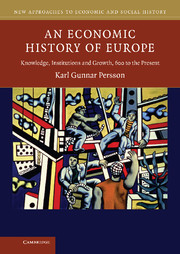Book contents
- Frontmatter
- Contents
- List of tables
- List of figures
- List of maps
- List of boxes
- Foreword
- Introduction: What is economic history?
- 1 The making of Europe
- 2 Europe from obscurity to economic recovery
- 3 Population, economic growth and resource constraints
- 4 The nature and extent of economic growth in the pre-industrial epoch
- 5 Institutions and growth
- 6 Knowledge, technology transfer and convergence
- 7 Money, credit and banking
- 8 Trade, tariffs and growth Karl Gunnar Persson and Paul Sharp
- 9 International monetary regimes in history by Karl Gunnar Persson and Paul Sharp
- 10 The era of political economy: from the minimal state to the Welfare State in the twentieth century
- 11 Inequality among and within nations: past, present, future
- 12 Globalization and its challenge to Europe
- Glossary by Karl Gunnar Persson and Marc P. B. Klemp
- Index
Foreword
- Frontmatter
- Contents
- List of tables
- List of figures
- List of maps
- List of boxes
- Foreword
- Introduction: What is economic history?
- 1 The making of Europe
- 2 Europe from obscurity to economic recovery
- 3 Population, economic growth and resource constraints
- 4 The nature and extent of economic growth in the pre-industrial epoch
- 5 Institutions and growth
- 6 Knowledge, technology transfer and convergence
- 7 Money, credit and banking
- 8 Trade, tariffs and growth Karl Gunnar Persson and Paul Sharp
- 9 International monetary regimes in history by Karl Gunnar Persson and Paul Sharp
- 10 The era of political economy: from the minimal state to the Welfare State in the twentieth century
- 11 Inequality among and within nations: past, present, future
- 12 Globalization and its challenge to Europe
- Glossary by Karl Gunnar Persson and Marc P. B. Klemp
- Index
Summary
This book evolved over the years from the lectures I have given and give to my students at the Department of Economics in Copenhagen. I have, however, attempted to write a book for a wider audience who are searching for a very concise introduction to European economic history which is in tune with recent research. I make use of a few basic and simple economic tools which turn out to be very effective in the interpretation of history. The book offers a panoramic view rather than close-ups. However, the analytical framework will be useful in further studies of the specialized literature. For readers with little background knowledge in economics I provide a glossary defining key concepts, which are marked by italics and an asterisk, for example barter*. Economic ideas demanding more attention are explained in the text or in appendices.
This is a work of synthesis, but it attempts to give challenging and new insights. I am indebted to generations of economic historians as well as to a great many of my contemporaries. That normally shows itself in endless footnotes, which not only interrupt the narrative flow but also drown the general historical trends amidst all the details. Instead, I have chosen to end each chapter with a selective list of references which is also a suggestion for further reading. Authors I am particularly influenced by are referred to in the main text.
- Type
- Chapter
- Information
- An Economic History of EuropeKnowledge, Institutions and Growth, 600 to the Present, pp. xv - xviPublisher: Cambridge University PressPrint publication year: 2010

